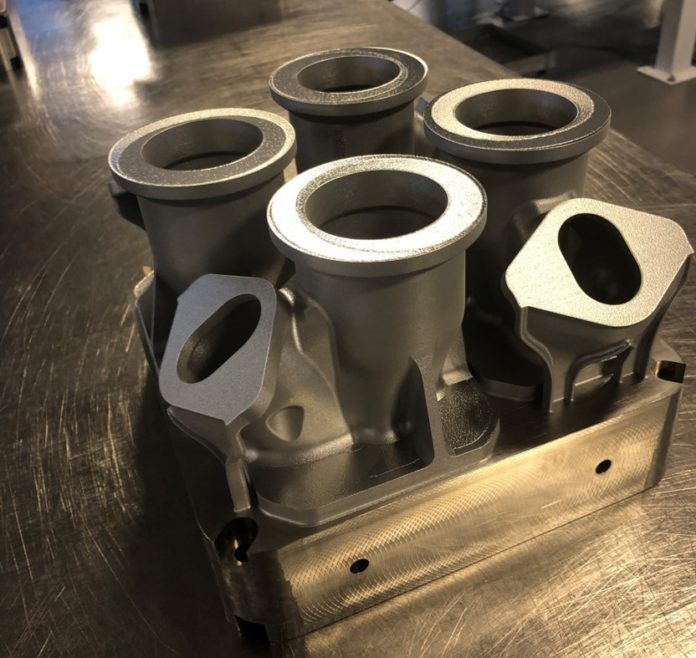It is the first time GE Aviation had shifted production from investment casting to AM based strictly on cost and today, both companies see potential for hundreds more
Sister technology companies GE Aviation and GE Additive are currently undertaking a cost and time to market analysis to change the manufacturing process of several aerospace parts. The validated parts will no longer be produced by casting but rather by metal 3D printing.
According to the experts, that’s a risk most manufacturers would not take if they already had paid for the casting mold. Well, GE Aviation is not like any other manufacturer as the company is switching four bleed air parts from a land/marine turbine, from castings to metal AM.
According to the cost and time to market analysis, the four 3D-printed parts will decrease the costs by 35%, which is already a valid reason to turn to metal AM technology. Furthermore, as far as the timing is concerned, it took 10 months to both teams to assess the parts’ candidacy for 3D printing final prototypes, whereas it usually required 12 to 18 months or more to produce aerospace and land/marine turbine parts using a casting process.
“This is the first time we’ve done a part-for-part replacement, and it was cheaper doing it with additive than casting. To make sure we demonstrated cost competitiveness, we had four outside vendors quote the parts, and we still came in lower with additive manufacturing”, GE Aviation’s additive manufacturing leader Eric Gatlin said.
How was the transformational process performed?
Early at the beginning of last year, the GE Aviation team started an annual audit of castings to see if they could pull costs out of existing products. The ultimate goal was to determine if they could be more competitive, and achieve things they “couldn’t do a year ago that are now technically feasible”. According to Gatlin, they cast a wide net that includes hundreds of castings they buy.
As both new and older products were assessed, the team took into account several factors, such as the capabilities of GE Aviation’s 3D printers, part size, shape, materials, the ease of post-processing steps, like machining to eliminate surface imperfections and brazing to add fittings to a part as well as other features.
The audit looked at both low-volume replacement parts and production-volume parts for new programs, like the LM9000 engine.
By February 2020, the GE Aviation team had already identified 180 cast parts for which they thought 3D printing could potentially save money. To make sure, a team of GE Aviation and GE Additive engineers, each using their own organization’s production and financial models, split into small groups to calculate the ROI on printing each part.
Interestingly, when the pandemic hit, it affected manufacturing operations for the aviation industry but on the other hand, provided more opportunity for in-house manufacturing teams to focus on other projects.
“We’re a production shop and would not see a project like this until after GE Aviation’s Additive Technology Center had developed the process for low-rate production,” said Jeff Eschenbach, a senior project manager and project lead at the Auburn facility. “What was different about this project is that we took this on from the very beginning. It created an opportunity for the engineers here on site to get involved.”
The manufacturing process
The four parts (3.5 inches in diameter and about six inches tall = 8.8 cm in diameter and 15 cm tall) have been chosen based on engineering resources which were the Concept Laser M2 machine in this case, and the importance of cost savings to the engine program. They were first produced by CoCr to withstand the hot compressed air from the turbine’s compressor section.

From a manufacturing standpoint, they shared a base geometry and similar features. The team assumed the M2 could print three parts at a time, but engineers soon redesigned the build plate layout to increase it to four. This immediately boosted productivity, because it takes about the same amount of time to print four parts as it does three parts.
“Using simulation and analysis, the team showed that the parts performed the same as the cast parts they replaced,” said Steve Slusher, a GE Additive manufacturing engineer on the project. The team also built test bars with each print, some in the open cavity of the cap that went down to the build plate, so technicians could measure the integrity of each production run.
“The parts were one-to-one replacements, without any redesign or parts consolidation to improve their economics,” Gatlin said. “And it was done fast.”
“The thing that stuck out to me,” Eschenbach said, “was that we could take an existing casting design, replicate it quickly on our printers, and within weeks of starting on the project, the final parts were the same quality as to their cast counterparts. This project serves as a template for future work.”
Remember, you can post job opportunities in the AM Industry on 3D ADEPT Media free of charge or look for a job via our job board. Make sure to follow us on our social networks and subscribe to our weekly newsletter : Facebook, Twitter, LinkedIn & Instagram ! If you want to be featured in the next issue of our digital magazine or if you hear a story that needs to be heard, make sure to send it to contact@3dadept.com






